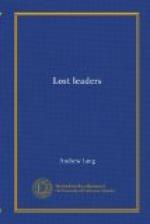Probably the most inattentive mind, even in the holidays, could “tackle” a catalogue like this, or another in which the snuff-box of Xerxes and the boot-jack of Themistocles should be offered for sale. These antiquities seem scarcely less desirable, or less likely to come into the market, than the scissors, pistols, and field-glass of Fernando Cortes. An original portion of the Tables of the Law (broken on a familiar occasion by the prophet), Hannibal’s cigarette case, a landing net (at one time in the possession of Alcibiades), a piece of chalk used by Archimedes in his mathematical demonstrations, the bronze shoe of Empedocles, the arrow on which Abaris flew, and the walking-stick, a considerable piece of timber, which Dr. Johnson lost in Mull, may all be reposing in some private collection. Collectors do get very odd things together. Poor M. Soleirol had quite a gallery of portraits and autographs of Moliere, and a French mathematician, about a dozen years ago, possessed an assortment of apocryphal letters from almost every one mentioned in history, sacred or profane. The collection of Mr. Samuel Ireland was like this, and an English student possessed autographs of most of the great reformers, carefully written by an ingenious swindler in contemporary books. The lovers of relics are apt to be thus deluded, and perhaps we should not regret this, as long as they are happy. But they should be very careful indeed when they are asked to buy Alvarado’s spear, though probably it is extant somewhere, as it certainly is in the catalogue. It is a question of caution in the purchaser.
CURIOSITY HUNTING.
What will people not collect in this curious age, and what prices will they not pay for things apparently valueless? Few objects can seem less desirable than an old postage-stamp, yet our Paris correspondent informs us that postage-stamps are at a premium in the capital of taste and of pleasure. A well-known dealer offers 4 pounds 15_s_. for every Tuscan stamp earlier than 1860, and 16 pounds for particularly fine examples. Mauritius stamps of 1847 are estimated—by the purchaser, mind—at two thousand francs, and post-marks of British Guiana of 1836, from five hundred to a thousand francs. Eighty pounds for a soiled bit of paper, that has no beauty to recommend it! Probably no drawing of equal size from the very hand of Raffaelle or Leonardo would be priced nearly so high as these grubby old stamps. Yet the drawing would be not only a thing of art, beautiful in itself, but also a personal relic of the famous artist whose pencil touched it, while a stamp is a relic of nothing but some forgotten postal arrangement with a colony. We do not know, moreover, how much the dealer will ask for these stamps when once he gets hold of them and has rich collectors at his mercy. In no trade do the buyer’s price and the seller’s price differ with such wide margins as in the commerce of curiosities, especially,




